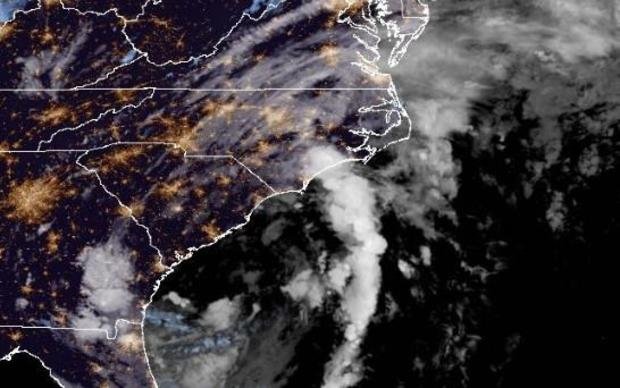Tropical Storm Debby is taking a breather over the western Atlantic but isn’t done dousing the coastal Carolinas before it slowly marches north.
Debby was expected to “continue to drift offshore through early Thursday and then move inland over South Carolina on Thursday,” the National Hurricane Center said. “Some additional strengthening is forecast while the center of Debby remains offshore. Weakening is expected Thursday night and Friday after landfall,” the center continued.
Debby was about 70 miles south of Charleston, South Carolina early Wednesday and about 75 miles east-southeast of Savannah, Georgia. It was crawling east-southeast at a mere 5 mph, with maximum sustained winds of 45 mph.

“Tropical cyclones always produce heavy rain, but normally as they’re moving, you know, it doesn’t accumulate that much in one place,” said Richard Pasch, of the hurricane center. “But when they move very slowly, that’s the worst situation.”
There will be lulls in the rain as dry spells appear between bands around the center of the poorly organized storm, forecasters said. But some bands will be heavy and keep moving over the same places.
Debby is forecast to finally pick up speed Thursday and could move up the middle of North Carolina, through Virginia, and into the Washington area by Saturday.
As Debby swirls just offshore, the heavy rain is expected to move into parts of South and North Carolina that have already seen two billion-dollar floods in eight years.
The slow-moving storm drenched coastal cities in Georgia and South Carolina late Monday into Tuesday, stirring up tornadoes and submerging streets with waist-high floodwaters. The storm has dropped more than a foot of rain in some places already and could dump staggering totals of up to 25 inches in some places by the time it ends.

The Miami-based hurricane center says that could cause “catastrophic flooding across portions of eastern South Carolina and southeast North Carolina through Friday.”
Several areas along North Carolina’s coastline are prone to flooding, such as Wilmington and the Outer Banks. Virginia could see impacts including strong winds, heavy rains, and flooding.
Rain totals in some areas of the Carolinas could come close to what the region saw in a historic flood from Hurricane Matthew in 2016. Two years later, many of those records were broken during Hurricane Florence. Both storms killed dozens.
Rain from Debby is being blamed for the deaths of at least five people — four in Florida — including two children — and one in Georgia.
Some 44,000 customers were still in the dark in Florida early Wednesday, according to PowerOutage.us.
Charleston and Savannah were deluged into Tuesday, with curfews set and roads blocked by police. Dozens of roads were closed in the city of Charleston because of flooding similar to what it sees several times a year because of rising sea levels.
In one Savannah neighborhood, firefighters used boats to evacuate some residents and waded through floodwaters to deliver bottled water and other supplies to those who refused to leave.
Michael Jones said water gushed into his home Monday evening, overturning the refrigerator and causing furniture to float. Outside, the water seemed to be everywhere and was too deep to flee safely. So Jones spent a sleepless night on his kitchen table before firefighters going door to door came in a boat Tuesday morning.
“It was hell all night,” Jones said.
In Charleston, Mayor William Cogswell said the road closures have kept businesses and homes from unnecessary damage and avoided the need for any high-water rescues.
“We especially don’t need any yahoos driving through the water and causing damage to properties,” Cogswell said.
North Carolina and Virginia have both declared states of emergency.
“The effects of Debby are far-reaching, and our neighboring states are facing significant challenges,” Virginia Gov. Glenn Youngkin said.
Green Pond in rural Colleton County, South Carolina, reported the most rain so far, just over 14 inches. A nearby dam had water run over its top but didn’t crumble, while trees and washouts blocked several roads, county Fire-Rescue Assistant Chief David Greene said.
Close to a foot fell down-coast from Charleston to Savannah, where the National Weather Service reported 6.68 inches on Monday alone. That’s already a month’s worth in a single day: In all of August 2023, the city got 5.56 inches.
Tornadoes knocked down trees and damaged a few homes on Kiawah Island and Edisto Island.
Crooked Hammock Brewery in North Myrtle Beach, South Carolina, decided to close early Tuesday.
“Flash flooding is super unpredictable, and we’d rather our staff and guests be home and safe,” marketing coordinator Georgena Dimitriadis said.
Far to the north in New York City, heavy storms that meteorologists said were being enhanced by Debby flooded some streets and expressways, stranding motorists. The National Weather Service issued a flood watch until noon Wednesday for the entire city.
Emergency officials warned of potential flash flooding, flying drones with loudspeakers in some New York City neighborhoods to tell people in basement apartments to be ready to flee at a moment’s notice.
About 500 people were rescued Monday from flooded homes in Sarasota, Florida, police said. Just north of Sarasota, Manatee County officials said more than 200 people were rescued.
Officials said it may take two weeks to fully assess the damage in parts of north-central Florida as they wait for rivers to crest.
“You’re going to see the tributaries rise. That’s just inevitable. How much? We’ll see,” Florida Gov. Ron DeSantis said Tuesday. “It may be that it’s not flooded today and it could be flooded tomorrow.”
Georgia Gov. Brian Kemp also warned of more rain and flooding to come, saying, “Do not let this storm lull you to sleep.”
President Biden approved emergency declarations, making federal disaster assistance available to Florida, Georgia, and South Carolina.
Debby made landfall as a Category 1 hurricane early Monday along the Gulf Coast of Florida before weakening into a tropical storm.
